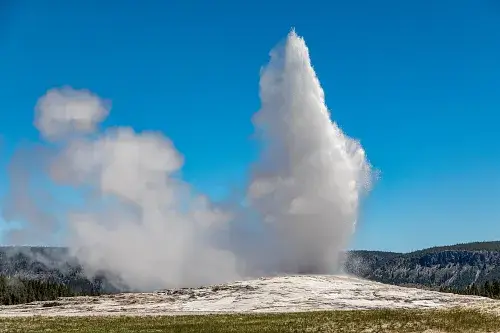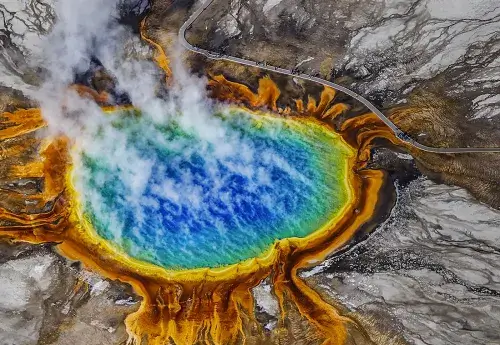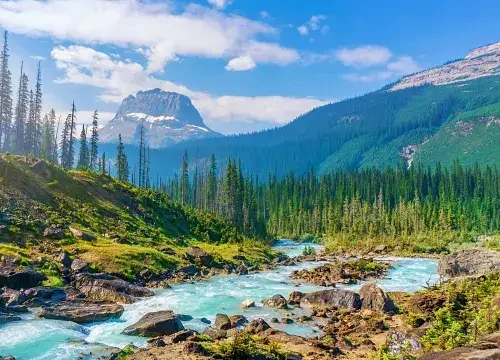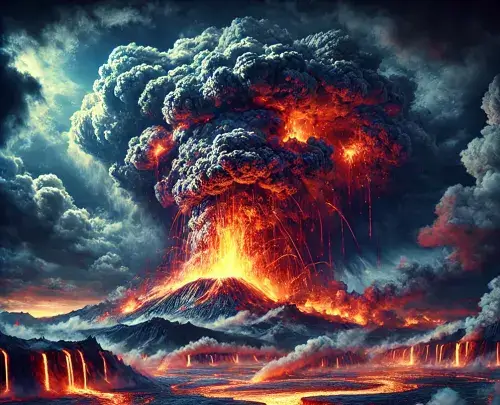Yellowstone, a unique natural marvel, hides the potential for a global catastrophe. Hence, the prophetic question arises: how long until the inevitable?
But let’s not begin with a gloomy tone. Instead, let’s take a brief tour of this extraordinary U.S. national park.
Many have visited, but for those who haven’t and wish to know more, here’s an introduction.
Yellowstone National Park.
Officially established in 1872, Yellowstone has been shaped by nature over thousands of years.
Renowned for its unique ecosystem and breathtaking landscapes, the park spans the western United States and offers visitors a glimpse into a rich tapestry of natural wonders.
From mountains and forests to lakes and geothermal geysers, Yellowstone’s landscapes are as diverse as they are awe-inspiring.
Among its most iconic attractions are the geysers, which draw thousands of tourists annually.
The most famous, “Old Faithful“, lives up to its name with its predictable eruptions, sending streams of boiling water up to 60 meters into the air.
 Another natural masterpiece is the Grand Prismatic Spring, one of the largest hot springs in the world.
Another natural masterpiece is the Grand Prismatic Spring, one of the largest hot springs in the world.
Its vivid colors and immense size leave visitors spellbound.
 These natural wonders not only provide stunning views but also host a unique ecosystem teeming with countless plant and animal species, including rare and endangered ones.
These natural wonders not only provide stunning views but also host a unique ecosystem teeming with countless plant and animal species, including rare and endangered ones.
Visitors can encounter a variety of wildlife, from majestic grizzly bears to industrious beavers.
However, they must also remain cautious of the potential dangers posed by this delicate yet dynamic environment.
Geothermal activity is a significant hazard.
Temperatures in the park’s hot springs can exceed 90 degrees Celsius (194 degrees Fahrenheit), requiring visitors to exercise extreme care while marveling at these extraordinary features.
Preparing for the Unthinkable.
Yellowstone is not just a beloved destination; it is also a reminder of nature’s unpredictability.
The park’s visitors must prepare for potential risks such as wildfires, earthquakes, and even volcanic eruptions.
Step 1: Develop a Safety Plan.
Familiarize yourself with park resources to identify potential dangers and select safe trails and campsites.
Create an emergency evacuation plan, marking routes and safe havens in case of sudden crises.
Step 2: Stock Essential Supplies.
Visitors should prepare for emergencies by bringing adequate food, water, medication, and survival tools.
A first aid kit, protective gear, and communication devices are essential for navigating unforeseen challenges.
The Shadow of a Supervolcano.
Beneath Yellowstone lies one of the world’s largest supervolcanoes.
This massive magma chamber holds the potential for a catastrophic eruption. If such an event were to occur, the consequences would be dire.
1. Immediate Destruction.
Regions near Yellowstone would be obliterated within minutes or hours by pyroclastic flows—clouds of scorching ash and gas traveling at high speeds.
2. Ash Fallout Across the Continent.
Vast quantities of volcanic ash would blanket much of the U.S., decimating agriculture, contaminating water supplies, and crippling infrastructure.
3. Global Climate Impact.
Sulfur dioxide released into the atmosphere would form aerosols, reflecting sunlight and triggering a “volcanic winter.”
Global temperatures would drop for years, severely affecting agriculture and food supplies worldwide.
Implications for Humanity.
The direct death toll near Yellowstone could reach 100,000, while the indirect effects—such as ash inhalation, food shortages, and extreme cold—could result in millions of casualties globally.
The United States would face unparalleled challenges, including economic collapse, infrastructure paralysis, and an insurmountable refugee crisis.
The ripple effects would extend worldwide, destabilizing economies and triggering international conflicts over scarce resources.
Ash Blanket Across the Continent.
A colossal amount of volcanic ash would be released into the atmosphere, blanketing vast areas.
Central and eastern regions of the U.S. would be smothered under thick ash layers, destroying crops, contaminating water supplies, and crippling infrastructure.
Global Climate Change.
A volcanic winter would likely ensue due to the release of sulfur dioxide, forming aerosols that reflect sunlight.
This could drastically lower global temperatures for years, disrupting agriculture and food supplies on a massive scale.
This scenario could also reshape geopolitics. Nations like China or Russia might attempt to fill the void left by a diminished U.S., potentially altering the balance of power on the global stage.
Survival Strategies and Evacuation Options.
• By Car: Fast but vulnerable to roadblocks and ash damage to engines.
• By Train: Stable but dependent on operational infrastructure.
• On Foot: Slow but independent of transportation systems.
 Essentials for an Emergency Pack:
Essentials for an Emergency Pack:
• High-energy food and water purification tools.
• Respirators or N95 masks to protect against ash inhalation.
• Maps, compasses, and multi-tools for navigation and survival.
• Warm, layered clothing and sturdy footwear.
• Communication devices and a charged power bank.
A Sobering ReminderYellowstone’s supervolcano eruption would be one of the most devastating events in human history, underscoring humanity’s vulnerability to nature’s raw power.
While such an event may not occur for thousands of years—or at all—it serves as a reminder to value preparedness and resilience.
So, what would you do if faced with such a scenario?
Whether escaping by car, train, or on foot, preparation is key. Let’s hope the day never comes, but if it does—be ready.
P.S. It probably won’t happen this year…
Have a good day!



